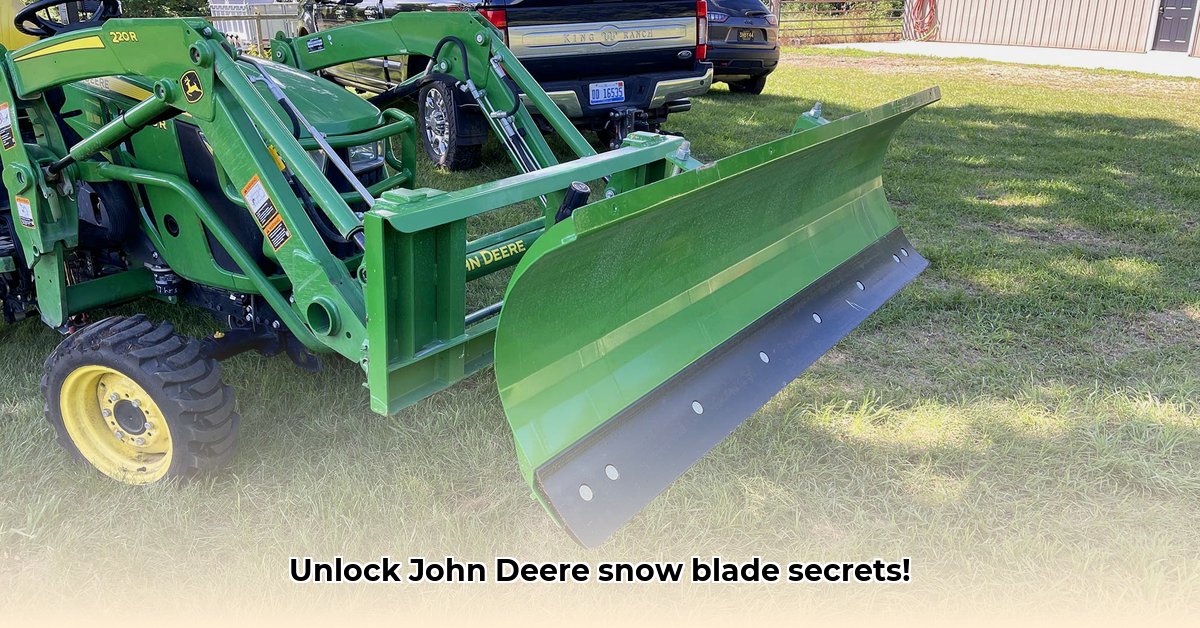
Snow Blade Selection for Optimal Winter Farm Operations
Winter's impact on farming operations can be significant, but efficient snow removal mitigates disruptions. A John Deere tractor snow blade offers a powerful solution, but selecting the right equipment is crucial for maximizing efficiency and minimizing environmental impact. This guide helps farmers make informed decisions, focusing on equipment selection, installation, operation, maintenance, and sustainability considerations. For larger operations, consider a three-point snow blower.
Matching the Blade to Your Farm's Needs
Choosing the right John Deere snow blade hinges on several key factors:
Farm Size and Snowfall: A smaller farm with light snowfall might only need a lightweight blade, while a large operation in a high-snow region requires a more robust model, potentially a snow blower. What's the average snowfall in your region, and what area needs clearing?
Tractor Compatibility: Crucially, ensure the chosen snow blade is compatible with your John Deere tractor's model, lift capacity, and mounting points (three-point hitch or front loader). Incorrect matching leads to performance issues and potential damage. Consult your tractor's owner's manual to ensure compatibility.
Budgetary Considerations: Factor in not only the initial cost of the blade but also the ongoing costs of maintenance, repairs, and fuel. How does the total cost of ownership (TCO) compare to alternative solutions? 1
Understanding Attachment Mechanisms
John Deere snow blades primarily use two attachment methods:
Three-Point Hitch: A common rear-mounted system offering stability and ease of use.
Front Loader Mount: Offers improved visibility, particularly beneficial in confined areas.
Snow Blades vs. Snow Blowers: Which is Right for You?
The choice between a snow blade and a snow blower depends on your specific needs.
Snow Blades: Ideal for lighter snowfalls, offering a cost-effective solution for pushing snow.
Snow Blowers: Best suited for heavier snowfalls, effectively throwing snow to a greater distance. They are generally more expensive and require more maintenance.
Remember to consider your average annual snowfall and the terrain of your farm.
Installing and Operating Your John Deere Snow Blade
Safe and efficient operation of your snow blade is paramount. Follow these steps:
Safe Attachment: Carefully align the blade with your tractor's mounting points, following the manufacturer's instructions precisely. Double-check all connections before starting.
Hydraulic System Familiarity: Familiarize yourself with your tractor's hydraulic controls – these adjust the blade's angle and lift height. Practice with the blade raised before tackling snow removal.
Safe Operation Procedures: Maintain awareness of your surroundings, keeping a safe distance from obstructions. Avoid overloading the blade; push smaller amounts of snow to prevent damage. Always maintain good visibility.
Regular Inspections: After each use, inspect for any damage (bent metal, loose bolts). Address minor issues promptly to avoid escalating problems.
Maintaining and Repairing Your Snow Blade: Extending its Lifespan
Regular maintenance prevents costly repairs and downtime.
Preventative Maintenance: Clean the blade after every use. Lubricate moving parts according to the manufacturer's schedule. This practice significantly extends equipment lifespan.
Blade Sharpness: A sharp blade is more efficient and less prone to damage. Sharpen or replace worn cutting edges as needed.
Troubleshooting: Familiarize yourself with common troubleshooting steps. Addressing minor issues early can prevent major repairs. If problems persist, consult your John Deere dealer.
Sustainability in Snow Removal: Minimizing Environmental Impact
While essential for farming, snow removal has environmental implications.
Soil Protection: Prompt snow removal prevents extended periods of heavy machinery operation on frozen ground, reducing soil compaction and preserving soil structure.
Durable Equipment: John Deere's durable construction minimizes the need for frequent replacements, reducing waste.
Future Improvements: Ongoing research is needed to further enhance the sustainability of snow removal equipment. The use of recycled materials, more efficient engines and environmentally friendly hydraulic fluids are all areas for improvement. Governmental incentives could promote the use of eco-friendly equipment.
Cost-Benefit Analysis: Weighing the Costs and Benefits
A cost-benefit analysis should compare the cost of purchasing and maintaining a John Deere snow blade against the costs of alternative methods (hiring contractors, etc.). Consider:
Initial Purchase Price: The upfront cost of the equipment.
Maintenance & Repair Costs: Include routine maintenance, repairs, and parts replacements over the equipment's life.
Operational Costs: Consider fuel consumption and labor costs.
Resale Value: Account for the potential resale value of the equipment at the end of its useful life.
By carefully considering all of these factors, farmers can make an informed decision based on their individual circumstances.
Case Study: Farmer Success Stories
(Space for a farmer testimonial detailing successful use of John Deere snow removal equipment and the benefits experienced. This will require additional information.)
Extending the Life of Your Snow Blade: Practical Tips
Proper Storage: Store the blade properly during the off-season to prevent corrosion and damage.
Regular Cleaning: Thorough cleaning after each use prevents the build-up of corrosive materials.
Operator Training: Proper training ensures safe and efficient operation, extending the lifespan of the equipment.
By following these guidelines, farmers can effectively utilize John Deere snow removal equipment, boosting farm productivity and sustainability. Remember, combining informed decision-making with proper maintenance practices ensures a high return on investment and minimizes environmental impact.